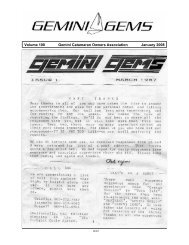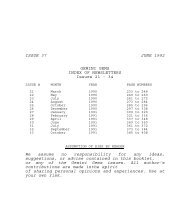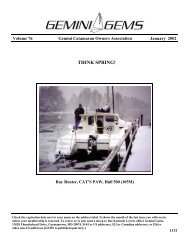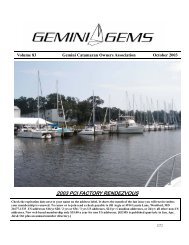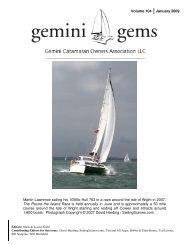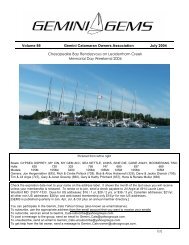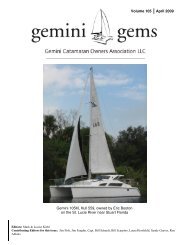Gemini Owners Manual.pub - Gemini Gems
Gemini Owners Manual.pub - Gemini Gems
Gemini Owners Manual.pub - Gemini Gems
You also want an ePaper? Increase the reach of your titles
YUMPU automatically turns print PDFs into web optimized ePapers that Google loves.
<strong>Gemini</strong> 105Mc Owner’s <strong>Manual</strong><br />
with a lose luff and permanent curve. This sail<br />
works well on a reach and close to the wind. The<br />
base of the sail is mounted on a curved track traveling<br />
between both hulls. For downwind use, the<br />
base of the sail can be moved to windward, lessening<br />
the main sail’s wind shadow and increasing<br />
power. For upwind work in light air, the base of<br />
the sail can be positioned amidships.<br />
The screacher lines connect through two snatch<br />
blocks on either side (at the base of the stanchions)<br />
and then to the pad eye on the back of the combing.<br />
The snatch blocks enable fine tuning the sail’s<br />
roach for upwind or downwind performance.<br />
To correctly tension the screacher halyard, first<br />
loosen the backstay with the backstay adjuster (if<br />
not already loose). Hand-tighten the screacher<br />
halyard, then re-tighten the backstay. Keep in<br />
mind, the screacher sail has a permanent curve<br />
built in and is not intended to be completely<br />
straightened. Do not attempt to tighten the<br />
screacher halyard using the winch.<br />
The sail is protected from the sun with tedlar film<br />
which is light-weight and offers good UV protection.<br />
However, the tedlar film lacks durability so it is<br />
advisable to lower and stow the screecher if you<br />
don’t plan on using it for a long stretch of time<br />
(more than 2 weeks). The sail furls on its own luff<br />
wire and it must be furled in the direction that<br />
tightens the lay of the luff wire. Furling the sail in<br />
the wrong direction will unlay the wire and possibly<br />
kink and break the wire. To be sure the sail is<br />
furled correctly, check to see that the clear tedlar<br />
film is on the outside of the furled sail.<br />
To lower the sail, center the furling, un-cleat the<br />
halyard at the base of the mast and free the halyard<br />
stopper located about 5’ up from the base of<br />
the mast. Slack the sail enough so that you can<br />
easily pull the quick-release pin from the base of<br />
the sail – being careful not to loose the pin overboard.<br />
Place the base of the sail into the sail<br />
locker and continue lowering the sail using the halyard.<br />
Reefing<br />
The roller genoa in the full out position has the<br />
genoa sheet going down at approximately 45º to the<br />
slider which is near the back of the track. As the<br />
sail is rolled in, it is necessary to move the slider<br />
forward. The approximate slider position, when the<br />
tack of the genoa is in line with the shroud, is with<br />
the slider level with the checkstay eye. The reason<br />
for the correct position of the slider is to put<br />
roughly equal tension on the leach and the foot of<br />
the sail. This position will change in different wind<br />
strengths. In lighter winds the slider is further aft<br />
putting less tension on the leach, allowing the leach<br />
to fall away and not rub on the shrouds or close up<br />
the slot. In stronger winds the slider is forward to<br />
put more tension on the leach which is being blown<br />
out with the stronger winds.<br />
Suggested wind strength before reefing:<br />
Main Headsail Roller Genoa Wind<br />
Strength—<br />
Apparent<br />
Full Main Drifter Full 15 knots<br />
Full Main Genoa Full 18 knots<br />
Full Main Jib First Reef 22 knots<br />
Main – 1 st<br />
Reef<br />
Main – 1 st<br />
Reef<br />
Main – 2 nd<br />
Reef<br />
To use the above guide, when the boat has a roller<br />
genoa, simply reduce the sail as indicated above.<br />
The roller genoa is reduced to a jib when the tack is<br />
level with the shrouds and then can be further reduced<br />
to storm jib when in line with the baby stay<br />
on the front deck.<br />
As a rule of thumb, consider reefing whenever the<br />
boat heels to 7º or more. An inclinometer will assist<br />
in determining the degree of heel.<br />
Heavy Weather<br />
Sails and Sailing<br />
Jib First Reef 25 knots<br />
Storm Jib Second Reef 30 knots<br />
Storm Jib Second Reef Gale<br />
For offshore use, the catamaran is the safest choice<br />
of boat. The trimaran is the worst followed by the<br />
monohull. To understand what happens in rough conditions<br />
and large waves it is necessary to understand<br />
the motion of water in a wave.<br />
In the crest of a wave, water particles are moving in<br />
the direction of the wave with say a speed of 12<br />
knots. In the trough, the water particles are moving<br />
backwards at 12 knots. The water particles move in<br />
a circular motion. Although these waves appear to<br />
be moving, in fact nothing moves, there is just this<br />
circular motion of water. Otherwise the whole of the<br />
Atlantic would end up in Europe in a Gale.<br />
All boats will lay beam to the waves and wind with<br />
no sails up.<br />
In heavy weather, a monohull’s keel can by its own<br />
worst enemy. In the trough of a wave when laying<br />
beam to, the deep keel is in static water, while the<br />
hull is on the surface where the water particles are<br />
moving towards the wave. This starts a pendulum<br />
motion with the boat rocking towards the wave. As<br />
the pulsation of the wave moves on the hull, it is<br />
Copyright © 2004 Performance Cruising Inc.<br />
35



